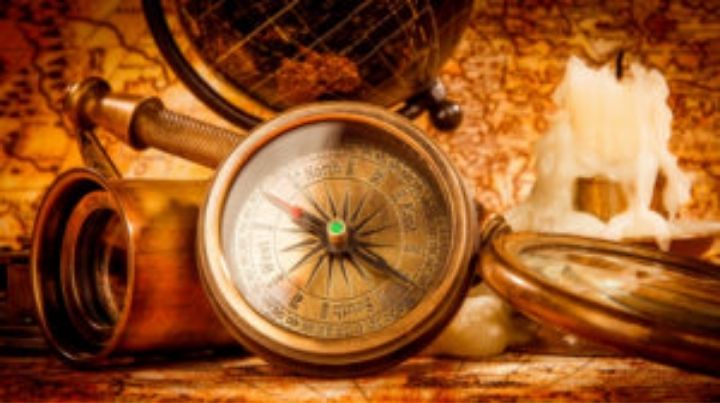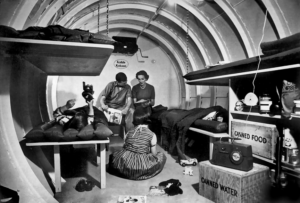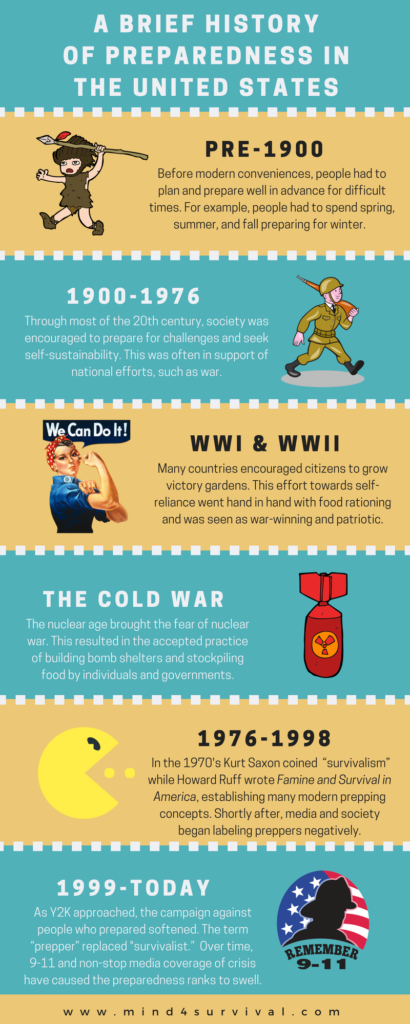The History of Survivalists and Preppers

Getting ready for disasters or preparing for a time that is not abundant is nothing new. You can find records and evidence of survivalists and preppers in the earliest points in history.
Survivalists and Preppers of the Ancient Times – 1900
The history of survivalists and preppers is traceable back to the earliest of human times. One only needs to look to the story of Noah and his ark for an example of preparing for a natural disaster. Following the great flood, both human history and the history of prepping are full of examples of people who prepared in advance to overcome future challenges.
Humans have preserved food since the earliest days. Without our modern conveniences, people had to plan and prepare well in advance for trying times. For example, in the Middle Ages, people preserved food in the summer so they could eat in the winter. Because of the expense associated with feeding animals in the winter, most were slaughtered in the fall. Once killed, they were preserved to supply meat through the winter.
This basic need for preparing for adversity continued for thousands of years. It continued because it was necessary for survival. Without preparing, most would have surely perished. Imagine winter in the 1800s without pre-chopped wood or preserved food. The history of prepping is full of examples of those who did not think ahead or prepare and proved Darwin right.
Survivalists and Preppers of the 1900 – 1970s
Even in our more recent history, preparing for adversity was accepted and encouraged the practice. Through most of the 20th century, people and governments urged people to prepare for challenges and seek some level of self-sustainability. In many cases, this was a motivating effort for a country’s citizens to help support a national effort by becoming what we’d now call survivalists and preppers.
World War I & World War II
Numerous countries involved in the wars encouraged their citizens to plant “victory gardens.” The promotion of victory gardens went hand in hand with the rationing of food. These campaigns for survivalists and preppers-type self-reliance became patriotic endeavors that would help win the wars.
In the United States, the effort to motivate the population into improved self-reliance was successful and resulted in the planting of 20 million victory gardens. In 1944, these victory gardens produced over eight million tons of fruits and vegetables. Victory gardens accounted for 40% of all fresh fruits and vegetables consumed in the United States and were equal to all commercial U.S. production.
During WWII, some feared that German aerial bombing was not far behind the U-Boat attacks that targeted the eastern coast of the United States. Therefore, another preparedness action taken by many was the construction of home bomb shelters. Many of these bomb shelters still exist today.
The Cold War
With the end of WWII, the world entered the nuclear age. Along with the atomic age came the fear of nuclear war between the world’s superpowers. This concern  resulted in the building of bomb shelters throughout the United States by individuals and local and federal governments.
resulted in the building of bomb shelters throughout the United States by individuals and local and federal governments.
Perhaps one of the most famous and massive bomb shelters is the Greenbrier Resort in West Virginia. The Greenbrier project began in 1958. The project, known as “Project Greek Island,” would become the potential shelter for 1,100 people, including the US Congress. The Greenbrier remained in operation until 1992, when it was outed by the media. Had it not been exposed by the media, it would probably still be part of the federal government’s survival plan today. However, while the US government may not plan on using the Greenbrier today, there are undoubtedly other Greenbriers standing by for a cataclysmic event.
The government not only built shelters such as the Greenbrier, but it also instituted “duck and cover” education and drills. Ask anyone who was a child of the times. They will most likely be able to recall watching public safety films, such as Atomic Alert, and conducting nuclear bomb drills. These drills followed guidance similar to what the US Army’s Field Manual, FM 3-4 NBC Protection provides:
“Nuclear attack indicators are unmistakable. The bright flash, enormous explosion, high winds, and mushroom-shaped cloud clearly indicate a nuclear attack. An enemy attack would normally come without warning. Initial actions must, therefore, be automatic and instinctive. Dropping immediately and covering exposed skin provide protection against blast and thermal effects.”
These widely accepted Cold War preparedness measures continued well into the 1970s.
The Survivalists and Preppers of the 1970s – 1998 
The next phase in the history of survivalists and preppers began in the mid-1970s. It was in 1976 that Kurt Saxon coined the phrase “survivalism.” It was also during the mid-1970s when Howard Ruff wrote his book Famine and Survival in America. Ruff’s book, based upon the turbulent financial times, helped lay the foundational concepts of today’s modern prepper philosophy. At the same time, the start of the contemporary firearms movement began at the American Pistol Institute (now Gunsite Academy), founded in 1976 by USMC Lieutenant Colonel Jeff Cooper.
Unfortunately, as the 1980s progressed into the 1990s, the media and a large portion of society began to negatively label people who took preparedness actions. The media wrongfully combined anyone and any group who practiced preparedness into one targeted group of wrongdoers. Rather than identify people and groups based on their merits, the press used blanket accusations in an attempt to paint all survivalists and preppers as crazy, racist, and anti-government. It was a deceptive but effective tactic that drove many well-intended but concerned people who engaged in preparedness to take their activities underground to prepare in secret.
Survivalists and Preppers of 1999
Fortunately, in the late 90s, as the specter of Y2K approached, the media campaign against people who prepared began to soften. Y2K was the fear that computers would shut down at the start of the new century due to a computer glitch.
The specter of Y2K resulted in the mainstream media running stories of potential power grid failures and societal shutdown. Fortunately, 2000 started without a hitch, and the prophecies of a Y2K doom never materialized.
However, what did materialize was a rebranding of the survivalist movement and preparing for adversity, which resulted in an overall increased acceptance across society.
Modern Survivalists and Preppers
With increased recognition, the word “prepper” replaced the word “survivalism.”
As it did, “survivalists” became “preppers.” That acceptance, while not complete, continued to increase and continues to do so today.
The terrorist attacks of September 11, 2001, ushered in a new age of ongoing worry and concern. That level of fear and anxiety is possibly the greatest in the history of preppers.
The Bottom Line on the History of Survivalists and Preppers
As time passed, the flames of worry and concern continued to be fanned by the never-ending 24-hour news cycle. It is this media-driven news cycle, which sensationalizes such tragedies. Events such as swine flu, avian influenza, Ebola, increased crime, repeated terrorist attacks, financial upheaval, etc., receive round-the-clock coverage. The fear of the sensationalized news stories drives more people to become concerned for their future safety and security. They are more willing to prepare for adversity. As a result, the prepper ranks continue to swell as it has at no other time in the modern history of prepping.
The explosion of the Internet further augments this increasing population of survivalists and preppers. With more and more prepper-related websites, blogs, and podcasts becoming accessible, the availability of information is unprecedented in the history of preppers. This availability of knowledge allows beginning preppers to become proficient and prepared within a short period. It also serves to demystify preparedness further, increasing society’s acceptance. In turn, this further increases the number of people willing to identify themselves as preppers.
The willingness for people to identify as survivalists and preppers is creating a widening definition of what it means to prepare. Some preppers consider a few days of food and a family emergency plan to be an adequate amount of preparedness. Others, however, desire to have a fallback location ready in the event they need to evacuate their family. Regardless of the desired amount of preparedness, there is one constant. That constant is that, as always, any readiness is better than no preparation.
Stay safe,

Additional Resources:
Middle Ages Food: LordsandLadies.org
Victory Gardens: LivingHistoryFarm.org
Bomb Shelters: OffTheGridNews.com
Don't Miss Out!
Join the thousands of people who rely on Mind4Survival preparedness advice by subscribing to our FREE newsletter.
- Practical preparedness information
- Zero Spam
- < 0.25% of people unsubscribe




Join Mind4Survival!
Stay informed by joining the Mind4Survival! 100% Secure! 0% Spam!
Follow Us!
Affiliate Disclosure
Mind4Survival is a free, reader-supported information resource. If you make a purchase through our link, we may, at no cost to you, receive an affiliate commission.



I’m left wondering why, when discussing preppers and preparedness I rarely see any mention of Mormons. They were the first “preppers” I was ever exposed to, long before the 21st century or even the Internet. Every Mormon family I’ve been around has just quietly built their “preps” including money while the rest of the country “fiddled”. ….and the Mormons I’ve known have always been willing to share their knowledge, even with this Baptist!
Thanks for your comment, David. I personally feel that I’ve heard Mormon preparedness spoken about many times. And, you’re right. I feel that they are so well known as preppers that perhaps they are overlooked in the discussion at times. Stay safe! ~Brian
Hey Brian. I enjoyed reading your article. I’m a college student looking to briefly interview someone who knows a thing or two about survivalism and prepping. It’s for an essay that I am writing. I’d like to email you some questions to get your viewpoint on this interesting topic. If interested, please email me back. I’m leaving my email in the box for this post. Thanks Brian.
Another great article. Oh, those Duck and Cover drills in the 60’s were great. As we all sat cross-legged in the halls of the elementary school with our hands over our head, even then I wondered how effective my hands would be to stop the roof from collapsing on us. Oh well, best intentions, I guess.